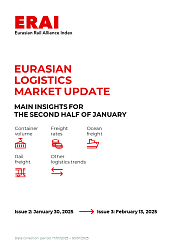The history of the project to build a railway from China to Uzbekistan through the Kyrgyz Republic is just under 30 years old. Its implementation is associated with both the national interests of Kyrgyzstan and Uzbekistan, and with China’s strategic objectives in Central Asia.
Chinese experts have formulated the concept of the so-called three continental bridges from China to Europe: the first is the Trans-Siberian Railway, including the Trans-Mongolian Corridor and several railway crossings directly from China to the Russian Federation; the second is the Trans-Kazakh railway line heading to Europe through the Russian Federation, the Caspian region and the countries of Central Asia, and also to Iran, with access to the Persian Gulf; the third is a potential railway corridor through Kyrgyzstan to Uzbekistan with further access to both South Asia through Afghanistan and Iran and to the Caspian Sea, with subsequent access to Southern Europe and Turkey. The advantage of the third bridge is a shorter distance and, accordingly, the delivery time of goods compared to other continental bridges. However, there is one nuance — and it is the most important — if two bridges actually exist and are actively developing, then the third one does not physically exist in nature, although a straight line between the existing railway stations of Kyrgyzstan and China is no more than 200 km long.
However, there are several key problems in the implementation of this project.
The first problem is the chronic poverty of the Kyrgyz economy and the impossibility of it implementing the project on its own and using its own production capacities.
The second problem is the large external debt of the Kyrgyz Republic and extremely limited opportunities to directly attract the necessary external financing, as well as simply provide a state guarantee for this project. At present, the public debt of Kyrgyzstan exceeds 50% of GDP, and the cost of the Trans-Kyrgyz Railway construction project has increased almost four times, coinciding with the amount of Kyrgyzstan’s external debt.
Thirdly, the period is too short from the point of view of a full assessment of the payback capacity of these railroads, which directly affects the payback time and the transition of the project from a conditionally geopolitical to a conditionally commercial one. This, in fact, is impossible without a great deal of income from the development of deposits along the route of the railway with certain branches to remote, but very important deposits. Not a single international development institution actively working with Kyrgyzstan has offered a sustainable payback model for the project and none has acted as a stakeholder.
Fourth, Kazakhstan has persistently rejected this project, having already built two full-fledged railway routes to China (Dostyk-Alashankou and Khorgos-Altynkol) and begun the construction of a third railway crossing. Moreover, Kazakhstan has interests in increasing freight traffic along the so-called Middle Corridor, also known as the former TRACECA project.
It is impossible to discuss the development prospects of a particular railway without taking into account the seismic danger of the region. The problem with a railway, unlike a hydroelectric power station or a nuclear power plant, is its length, which significantly reduces the chances of building it in a strictly safe zone. This factor can play a large role in increasing the costs of strengthening the railway track and the costs of rolling stock.
Thus, this project could either be narrowly regional and take into account the interests of the two Central Asian countries as much as possible, attract loans from international development institutions and diversified investments for this project in a balanced manner via the most transparent and extremely market conditions.
Kubatbek Rakhimov. 2025. «Analytics.» Valdai Club. 2025. https://valdaiclub.com/a/highlights/between-scylla-and-charybdis/.




